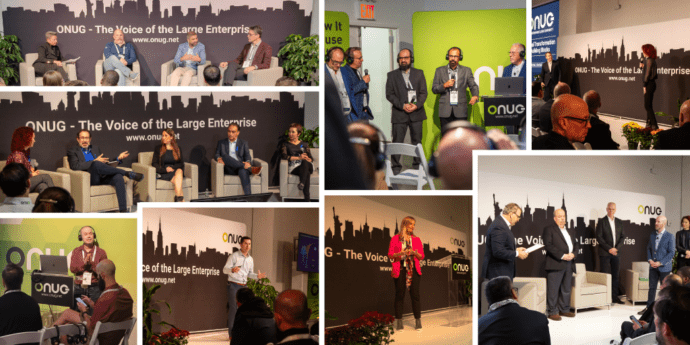
Winning Private 5G Use Cases
The ONUG Community is obsessed with use cases. Critical use cases for multi-cloud adoption determine the direction and outcomes of the ONUG Collaborative Working Groups. ONUG conference sessions feature enterprise IT professionals discussing and debating the merits of solutions for critical networking and security use cases critical to success in complex multi-cloud operations.
In 2023, ONUG launched a new private 5G (P5G) networks initiative that has culminated in the creation of the new Private 5G Event at ONUG Fall and the recent launch of the new Private 5G Working Group. The initial focus of this new initiative will be educating the ONUG Community on the rationale and business justification for P5G, establishing a baseline understanding of the compelling use cases for P5G networks across a wide range of industry verticals.
A strong use case focus will permeate each of the P5G conference sessions at ONUG Fall, but Verizon is sponsoring a session dedicated to “Winning Private 5G Use Cases,” which will feature a panel discussion moderated by a leading industry analyst, with speakers from Verizon, a P5G vendor, a solutions integrator and an enterprise adopter. Here I would like to briefly set the stage for this session by offering my perspective on classes of use cases driving P5G adoption across multiple markets.
Early private cellular deployments were mainly LTE-based, often in remote locations lacking any wireless network coverage. Mining and oil drilling operations are prime examples. Ultimately, these verticals will adopt P5G, but in many cases, private LTE connectivity is sufficient.
The market for P5G is projected to grow and encompass a broad range of industry verticals, roughly split into three use case categories: Internet-of-Things (IoT), Operational Technology (OT) and Information Technology (IT).
IoT use cases are dominated by wireless connectivity for large numbers of simple, low-power devices (sensors and actuators) that are likely to be distributed across a wide geographical area and have low bandwidth requirements. A private LTE network is typically adequate to support IoT use cases for these deployments, where high throughput is not needed and the lower LTE spectrum bands offer favorable propagation characteristics for effectively covering large geographical areas.
For example, utility companies have deployed private LTE networks for IoT device connectivity, often using licensed spectrum in the 900 MHz band. The 3GPP’s 5G NB-IoT (Narrowband IoT) standard is intended to support these low power wide area (LPWA) coverage use cases, but it is not yet a significant driver for P5G adoption.
OT use cases supporting machine-to-machine communications are the sweet spot for P5G networks and are gaining traction today in industrial, manufacturing, warehousing and logistics applications. In these environments, P5G provides high-bandwidth connections for highly mobile devices, autonomous unmanned vehicles, video cameras, smart machines, robots and drones. P5G offers the advantages of high performance, low latency and increased security compared to LTE or WiFi connectivity.
There are also compelling OT use cases for P5G people-to-machine communications, including AR/VR applications, equipment maintenance and worker training/safety.
The third class of P5G use cases integrates 5G connectivity as an alternative to WiFi for providing access to corporate network resources and IT applications. The drivers here are increased security and reliability for delivering mobile coverage across large-scale campuses and carpeted in-building environments.
Corporate WiFi isn’t going anywhere due to ubiquitous support for WiFi across a wide range of mass-produced devices, yet P5G is poised to gain the upper hand for mission-critical use cases where security and reliability are paramount concerns. Healthcare providers are keen to evaluate the benefits of P5G networks operating in licensed spectrum which is free from shared spectrum contention and enables wirelessly connected devices and equipment to be highly mobile within clinical medical facilities.
P5G will also spur the adoption of neutral host networks, allowing devices to roam seamlessly from a mobile operator’s public network onto the neutral host provider’s network. Large enterprises and commercial real estate landlords will deploy P5G neutral host networks to deliver high-quality in-building coverage while supporting high-performance, low-latency connectivity that far outpaces the capabilities of existing Distributed Antenna System (DAS) deployments.
While the future looks bright for P5G networks, use case adoption will be governed by the availability of devices that support 5G connectivity. Today, a wide range of readily available devices support LTE, with 5G support in the pipeline for upcoming releases.
In addition, 5G technology continues to advance at a rapid pace, with the 3GPP specifying new capabilities enabling new P5G use cases. As new standards are specified, chip makers will incorporate these capabilities into their designs, and the new silicon will then be integrated into a new generation of devices.
I hope this whets your appetite for learning more about P5G use cases, so please join us at the Private 5G Event at ONUG Fall to attend the “Winning Private 5G Use Cases” session, sponsored by Verizon, as well as the rest of the sessions in the P5G conference track.
Private 5G might not be “The Next Big Thing” (yet) but it’s not too early to begin contemplating your company’s P5G journey.


